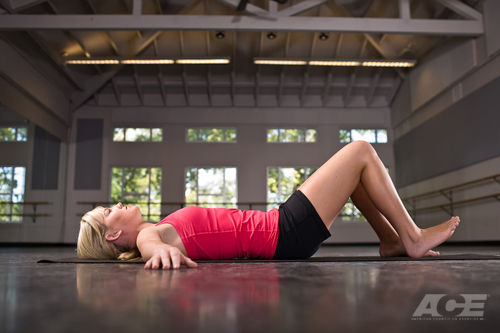Ab Exercises
Supine Hollowing with Lower Extremity Movements
- Target Body Part:
- Abs
- Equipment:
- No Equipment
- Difficulty:
-
 Beginner
Beginner

Step 1
Starting Position: Lie supine (on your back) on an exercise mat or firm surface, bending your knees until your feet are positioned flat on the floor 12 - 18" from your buttocks. Extend your arms out to your sides, palms facing either up or down (illustrated) at, or near shoulder level. Breathe deeply for a 30 seconds relaxing your body and allowing gravity to gently pull your lower back and shoulders towards the floor.
Step 2
Depress and retract your scapulae (pull your shoulder down and back) without increasing the arch in your low back or lifting your hips off the mat / floor. Hold this position throughout the exercise.
Step 3
Hollowing Movement: Breathe normally and at the end of your breaths (end-tidal volume), perform the following actions individually at first, then combine them together:
- Perform a gentle "kegel" contraction without moving your hips or ribcage (the kegel contraction of the pelvic floor is the same contraction your would perform when resisting the urge to urinate).
- Draw your belly button towards your spine without moving your hips or rib cage (visualize narrowing your waist circumference without taking a deep breath). Any movement of the hips or rib cage indicates activation of your larger abdominal muscles (e.g. rectus abdominis).
- Combining both 1 and 2 above.
- Combining 1 and 2, but counting out loud while breathing normally (i.e. holding the contractions through normal breathing)
Step 4
Exercise Progressions: Once your have spent time learning how to co-contract the muscles of the pelvic floor and core, independent of breathing, progress the exercise complexity by adding small movements in the lower extremity:
- Lift one leg 3 - 6" (no more) off the mat and hold this position briefly (illustrated) without moving your torso (hips, shoulders or increasing your low-back arch).
- Heel slide, lifting the toes in one foot off the floor and slowly sliding the heel of one foot 3-6" away from your body. without moving your torso (hips, shoulders or increasing your low-back arch)








